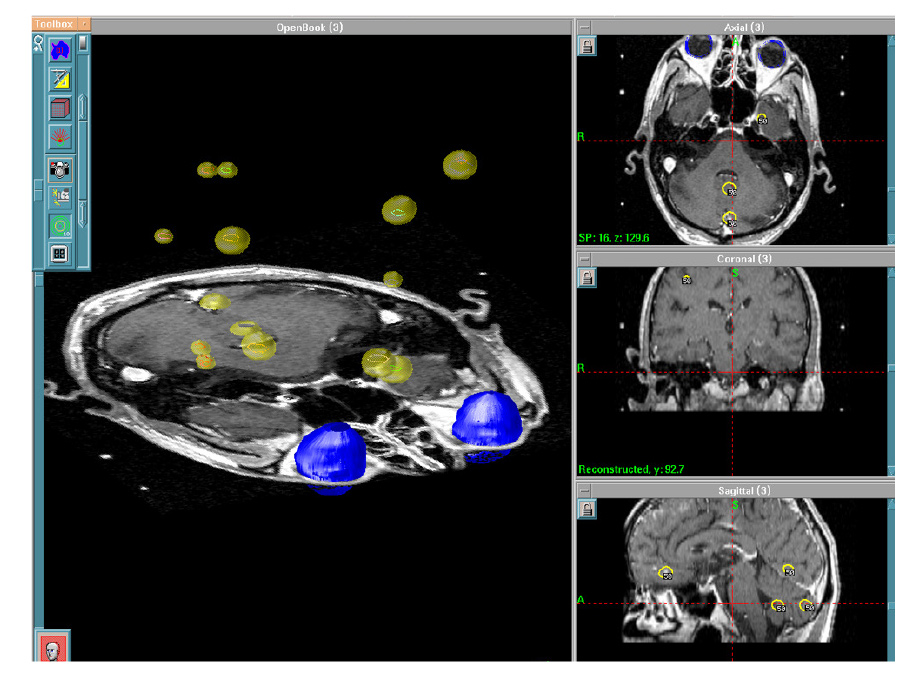Radiation that is delivered in a very targeted fashion only to the tumor sparing the surrounding normal brain is called stereotactic radiosurgery. Stereotactic radiosurgery may be done in a single session or up to five sessions. This form of treatment can be done by Gamma Knife or Linac based machines.
Gamma Knife (GK)
Gamma knife is the only form of stereotactic radiosurgery which is specifically used to treat brain tumors and other conditions of the brain. It is a highly sophisticated and accurate form of treatment for brain tumors that has changed the outcome of patients with brain metastasis. Gamma Knife can be used to treat one or multiple brain tumors in a single day as an outpatient. The latest version of GK is called ICON. Patients can undergo treatment with this machine using a frame or a mask. A very high dose of radiation is delivered to the tumor with acute precision, sparing the healthy tissue surrounding the target.
A few days prior to treatment, patients are contacted by the GK Center nurses. Our nurses are compassionate, skillful, and experienced. They will review treatment details with the patient and/or companion.
GK can either be done with a frame placement or a frameless mask, determined by the neurosurgeon and radiation oncologist, based on the tumor size and location. Patients arrive early in the morning and are greeted by our nurses. Up to two family members may join the patient in a private suite.
After the registration process is complete, the patient meets the radiation oncologist and anesthesia team. We use sedation to provide a more comfortable experience for our patients who require a frame placement. This procedure, called monitored anesthesia, is very similar to the anesthesia used for a colonoscopy or other minor procedures. If you are being prepared for a frame placement, it is unlikely that you will remember this part of the procedure.
An MRI is done upon completion of the frame placement. This MRI is then studied by Dr. Sahni and the entire team to create an individualized treatment plan. This process involves high level consultations between the neurosurgeon, radiation oncologist, and medical physicist.
Multiple Metastatic Brain Tumors Treated in One Session
Once the treatment plan (which involves a dose of radiation), the trajectory of the treatment, and the number of tumors is determined, the patient is taken to the treatment room. Families may wait in the patient’s suite or in the lobby. The duration of the treatment depends on the number and complexity of tumors. GK is the most accurate and safe form of treatment when the tumor is located in a very sensitive area, such as the brain stem.
Upon completion of treatment, the patient is brought back to the suite and the frame is removed. Afterwards, the patient’s family may join the patient again. Once the anesthesia wears off, the patient is discharged to go home.
For some patients, steroids and seizure preventive medications may be needed. Your team of doctors and nurses will go over all this with you.
Follow Up
We recommend one to two days off work after radiosurgery to stay home before resuming regular activities. Patients are advised to follow up with Dr. Sahni two months after any treatment.
An MRI is done before the follow-up visit. This is important because it can detect any new tumors before the patient becomes symptomatic. Unlike whole brain radiotherapy, which can be done only once, GK can be done as often as needed to treat new tumors. Your oncologist will be informed about your treatment and you should not miss your appointments with their office. If for some reason, you are not contacted for your follow-up appointment, call (804) 330-7099 and ask for Dr. Sahni’s nurse to arrange your MRI.
Linac-Based Radiosurgery Conventional linear accelerators have been refined to deliver radiation specifically to brain tumors, similarly to how they deliver radiation to the lungs or prostate. This is an acceptable alternative when patients have large tumors that are not located close to the brain stem. It is usually done with a mask. We do not use this technology if the tumor is small, or if it is too close to important structures such as the brain stem or optic nerves.
Dr. Sahni works closely with some of the most highly skilled radiation oncologists in town to provide this treatment using “TrueBeam” Linac-Based Radiosurgery. During your first consultation, these options and alternatives are discussed in detail. Patients are instructed to follow up with Dr. Sahni two months after this treatment for a new scan, just like GK patients.

Before Gamma Knife Treatment

3 Months After GK Treatment

GK ICON with Mask

Frame Based Targeted GK

Multiple Metastatic Brain Tumors Treated in One Session
